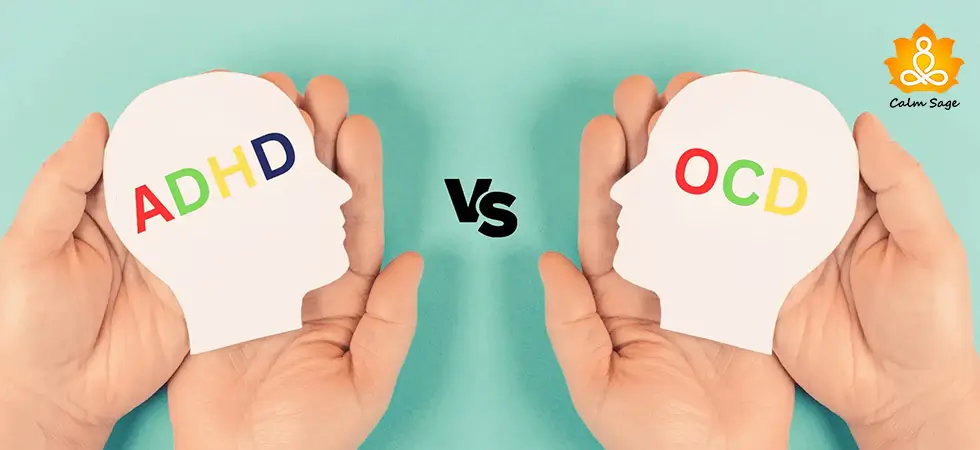What You Need to Know About Somatic OCD and Its Impact

The content in this article is thoroughly researched and written based on the extensive testing and reviewing by a reviews team and does not reflect the viewpoints of the Calm Sage editorial team. Calm Sage could receive a commission from product purchased mentioned or featured in this article.
Obsessive-compulsive disorder or OCD is a well-studied mental health condition that is characterized by intrusive and unwanted thoughts – obsessions – and repetitive behaviors or mental actions – compulsions.
These obsessions and compulsions drive you to perform in ways you wouldn’t normally engage in to ease the anxiety that follows them. Among so many subtypes of OCD, there’s one that is related to automatic body functions – Somatic OCD.
Somatic OCD, also known as sensorimotor OCD is a lesser known but equally distressing form of OCD. This subtype focuses on automatic body functions and sensations, often causing anxiety and distress.
Today, we’ll explore what somatic OCD is, its symptoms, the impact of it on your well-being, and how to cope (and treat) this disorder.
Somatic OCD: What is It?
Somatic OCD is a subtype of obsessive-compulsive disorder where you become hyper aware and obsessed with bodily sensations and functions. These sensations can include breathing, swallowing, blinking, and other automatic sensations that most of us take for granted. For someone with somatic OCD, these automatic body sensations become the center of their obsessions, causing them distress and disruption.
Certain characteristics that can help distinguish between somatic OCD and general obsessive worry can include:
- Having constant intrusive thoughts about automatic body functions and sensations
- Hyperawareness towards specific body sensations to a point of daily disruption
- To reduce anxiety caused by somatic OCD, engaging in repetitive behaviors
- Avoiding situations and activities that might trigger distressing thoughts
Somatic OCD Symptoms to Know
The symptoms of somatic OCD can vary depending from person to person, but some common somatic OCD symptoms can include:
- Constantly thinking about and monitoring specific body functions such as how many breaths taken, how many times you blinked, how many times did the heartbeat,
- Experiencing high levels of stress and anxiety that stems from the inability to stop or control such distressing thoughts.
- Engaging in repetitive behaviors or actions to try and control the focus on somatic sensations and other body functions.
- Trouble concentrating on other tasks, leading to decreased productivity and poor social and occupational functioning.
- Compulsively checking bodily functions to ensure that they are normal, such as checking the pulse, counting breaths, and counting swallowing.
- Actively avoiding situations or activities that might heighten awareness of the body functions. This can include avoiding exercising, meeting people, dining out, etc.
The Impact of Somatic OCD on Well-Being
The impact of somatic OCD on your well-being can be multifaceted. The constant focus on body functions and sensations along with the anxiety that follows can cause severe disruptions in various aspects of your life.
Psychologically speaking, somatic OCD can increase anxiety and stress. Moreover, the inability to control intrusive thoughts and the distress that comes with it can contribute to feelings of hopelessness and depression. Struggling with somatic OCD can also lead to feelings of inadequacy and low self-esteem.
Physically speaking, the mental effort to constantly monitor body sensations can be exhaustive, leading to physical fatigue. Anxiety and stress from somatic OCD can also disrupt your sleep patterns, resulting in insomnia and poor sleep quality.
If we talk about social implications of somatic OCD, then this disorder can cause you to avoid social interactions to prevent triggering obsessions. This can lead to social isolation. Moreover, you may find it hard to concentrate on work and other activities that can decrease productivity and performance.
While somatic OCD isn’t dangerous or harmful, its impact on your mental, physical, and social well-being can be huge. The chronic stress and anxiety associated with this disorder can cause other mental health issues such as depression, generalized anxiety disorder (GAD), and more.
How to Treat Somatic OCD?
Effective treatment for the condition can involve a combination of therapy, medication, and self-help strategies. Here’s how you can treat somatic OCD:
1. Cognitive behavioral therapy (CBT)
CBT is a well-recognized treatment approach for OCD. This technique focuses on identifying and challenging negative thoughts and behavior associated with the OCD and replacing them with positive ones. Another CBT technique to treat OCD can be exposure and response prevention therapy (ERP) wherein you are exposed – gradually – to your obsessions without engaging in compulsions.
2. Medications
Medications can also be prescribed to control the anxiety that comes with somatic OCD. A psychiatrist can prescribe you medications to reduce the symptoms of OCD. These medications work by increasing serotonin levels in the brain that can reduce anxiety and improve mood,
3. Mindfulness-based techniques
Another way to treat obsessive thinking is through mindfulness-based cognitive therapy and acceptance and commitment therapy. These techniques can help you by teaching you to accept the presence of intrusive thoughts without reacting to them. This can reduce their impact on your daily life.
4. Join support groups
Support groups can be a good way for you to gain a sense of community and understanding. Shared experiences and coping mechanisms from others with similar struggles can benefit your healing and recovery.
How to Cope with Somatic OCD?
Coping with somatic OCD can include techniques such as:
1. Mindfulness
Mindfulness involves paying attention to the present moment without judgment. This technique can help you become aware of your thoughts and sensations without becoming overwhelmed by them.
2. Practice Relaxation Techniques
Techniques such as deep breathing, progressive muscle relaxation, and guided imagery can help reduce anxiety and promote a sense of calmness.
3. Have a Routine
Having a structured routine can help reduce the uncertainty and anxiety that comes with somatic OCD. You can include physical activity, social meet ups, and self-care in your routine to feel good and less anxious.
4. Challenge Negative Thoughts
Learn to identify and challenge negative thoughts to reduce the impact of your obsessions. Cognitive restructuring can help here. You can also try to limit reassurance seeking and learn to tolerate uncertainty to cope with somatic OCD.
5. Seek Professional Help
When you begin to feel extremely distressed, when you can’t function normally, when self-help strategies stop helping, when other mental health issues persist, and when you begin to get thoughts of self-harm, it’s a signal to seek professional support and help.

Great for CBT Based therapists
-
$40/week, billed every 4 weeks
-
Therapy via messaging, phone, or live video chat
-
Specialization for CBT based Therapy
20% off your first month

Best for Treatment Plants
-
$60 to $90/week, billed every 4 weeks
-
Therapy via messaging, phone, or live video chat
-
Flexible cancellation at any time
$100 off your first month with code SPACE
Wrapping Up…
Somatic OCD is a misunderstood subtype of obsessive-compulsive disorder that makes you focus on body sensations. This type of OCD can increase stress and anxiety, and can impact your daily life and functioning. With the right treatment and coping strategies, you can learn to manage the symptoms and improve your well-being.
If you still struggle with somatic OCD symptoms, then don’t hesitate to seek professional help. Help is available to you. You just need to reach out.
I hope this blog will help you become aware of somatic OCD and its impact on your well-being. Let us know your thoughts in the comments below.
Take Care!




















